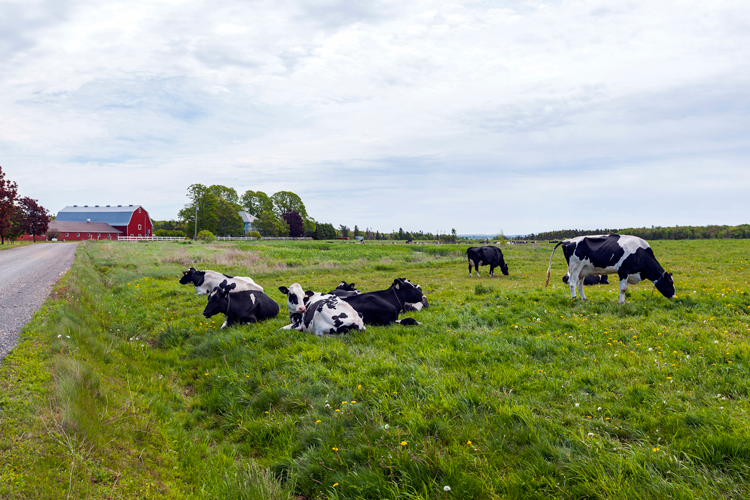|
|
|
|
|
|
By Nicole Ayache, Chief Sustainability Officer, National Milk Producers Federation

The Farmers Assuring Responsible Management Environmental Stewardship Program (FARM ES) is collaborating with the Innovation Center for U.S. Dairy to integrate a new, process-based model for greenhouse gas (GHG) accounting: the Ruminant Farm Systems (RuFaS) model. This rigorous, science-based (but user friendly) approach will position FARM ES as the key on-farm tool to support U.S. dairy community efforts to achieve its 2050 environmental stewardship goals, including to become GHG neutral or better. FARM ES is the U.S. dairy industry’s unified platform to track and aggregate on-farm environmental progress, with a suite of informational resources to support continuous improvement.
FARM ES will begin using RuFaS as its underlying GHG quantification model starting this summer with Version 3. This introductory launch will contain the core elements of the RuFaS model to enable farm-level GHG footprinting and scenario analyses, which help support informed decision-making about the adoption of practices and technologies. Further elements — like enhancements to the energy data inputs and conducting economic analyses — will be added to FARM ES as they become available through ongoing RuFaS research.
A key focus of the remainder this year will be to collect farmer, FARM evaluator, and other stakeholder feedback so the new platform can be refined in 2025.
Real-world refinement
The FARM Program relies on stakeholder feedback and guidance from the scientific experts at Dairy Management Inc. to guide its process of continuous improvement. Input from dairy farmers, cooperative and processor staff, and researchers informed the need to upgrade the GHG model that powers FARM ES. Stakeholders consistently requested a tool that can deliver insights as they evaluate opportunities to further improve on-farm environmental outcomes.
 Stakeholder engagement and participatory research continue to be essential as FARM ES begins the work to integrate the RuFaS model. A working group composed of farmers and staff from dairy cooperatives and processors meet with RuFaS researchers to discuss the scientific model and tool functionality. The multi-stakeholder working group has met seven times so far, covering the animal, manure, feed, energy, and economic RuFaS modules and giving feedback on the structure of data inputs, desired functionality for the new FARM ES tool, and more.
Stakeholder engagement and participatory research continue to be essential as FARM ES begins the work to integrate the RuFaS model. A working group composed of farmers and staff from dairy cooperatives and processors meet with RuFaS researchers to discuss the scientific model and tool functionality. The multi-stakeholder working group has met seven times so far, covering the animal, manure, feed, energy, and economic RuFaS modules and giving feedback on the structure of data inputs, desired functionality for the new FARM ES tool, and more.
More than 25 farms volunteered to participate in scientific model validation to support RuFaS calibration and refinement, with data collection complete in 2023. The volunteer farms ranged in size from 50 head to over 15,000 head and represent diverse geographies and production styles, including tie stalls, freestalls, dry lost, grazing, and more. The farms and the evaluators that supported their data collection were invited to provide written feedback and join live feedback sessions. They provided helpful guidance on topics such as ease and challenges in collecting and interpreting the data inputs, quality of data collection training in fully equipping evaluators, and the structure of the results report.
With the introduction of FARM ES Version 3, FARM will create feedback forms for farmers and FARM evaluators to provide suggestions. FARM also will host stakeholder webinars to foster discussion about the new platform.
This summer’s launch will bring exciting updates to FARM ES. They are only the beginning of the journey toward a more scientifically robust tool that brings greater insights to participating dairy farmers.
This column originally appeared in Hoard’s Dairyman Intel on March 18, 2024.
NMPF’s Executive Vice President Paul Bleiberg joins Dairy Radio Now this week to assess the impact of a new report from the House Agriculture Committee on the need that dairy farms and other ag employers have for farm workers, and what the prospects are for the push to expand the H2A visa program to dairy employers.
NMPF Executive Vice President Jaime Castaneda discusses efforts to expand dairy market access at recent World Trade Organization meetings in Abu Dhabi in an interview with the Red River Radio Network. Castaneda also discusses trade relations with India and the importance of the NMPF-led Cooperatives Working Together program for the future of U.S. dairy exports.
 By Paul Bleiberg, Executive Vice President, Government Relations, NMPF
By Paul Bleiberg, Executive Vice President, Government Relations, NMPF
Even as an election looms on the horizon, USDA will soon develop its Federal Milk Marketing Order (FMMO) modernization recommendations after months of proceedings. Meanwhile, Congress is preparing to advance a farm bill. U.S. dairy farmers and their cooperatives have a stake in both. But regardless of the policy landscape of the moment, one pressing priority that unites producers from coast to coast in every way, shape, and form is the need to restore the “higher of” Class I mover.
Since it was implemented five years ago, the current “average of” Class I mover has cost dairy farmers nationwide more than $1 billion in Class I skim revenue, with losses continuing to pile up monthly. This, of course, was not intended — but neither were the repeated price inversions that upended decades of data and showed the new mover is poorly adapted to dairy’s present and future in a variety of economic climates.
Congress changed the mover during the last farm bill to respond to fluid processor requests for risk management, but that was with the expectation that it would be revenue neutral for the dairy producer. Unfortunately, the new mover has been anything but revenue neutral, and it’s been so in a way that has overwhelmingly favored processors, who are not the epicenter of the FMMO system. The new mover has underperformed repeatedly, to the detriment of dairy farmers, in 2020, 2022, 2023, and again, month by month, in 2024. The current formulation has harmed farmers so consistently that it would have been nowhere close to revenue neutral even setting aside the calamity of 2020.
In an attempt to remedy an intolerable situation (everyone, even processors, agrees on that point, at least), several concepts have been put forth that are bandages to the problem but aren’t true solutions. Modifying the current formula, for example, to retroactively recoup producer losses would still fail to send timely price signals to farmers. The argument that this modified version would have paid more to farmers at some point just yet again exposes the problem with the “average of,” which is that it causes farmers to suffer losses when they should have been paid based on market signals and instead distorts the true market by paying them back later. That approach also provides little help to the many family dairy producers who don’t have years to be made whole, a fact underscored forcefully by continued trends toward farm consolidation.
The solution to this problem comes down to priorities. The current mover may have been a fair experiment to test, but with its performance now having been assessed, continuing the “average of” formulation can be to nothing except the detriment of dairy farmers who have lost more than $1 billion dollars of ongoing disorderly marketing of milk.
The right solution is the previous “higher of” mover. That tried-and-true approach, one that served farmers well for decades, responds quickly to and accurately reflects the marketplace, encouraging the orderly marketing of milk that provides the rationale for the FMMO system, and it helps dairy farmer cash flow when it counts. The “higher of” Class I mover must be reinstated.
This column originally appeared in Hoard’s Dairyman Intel on March 4, 2024.
ARLINGTON, VA – Cooperatives Working Together (CWT) member cooperatives accepted 41 offers of export assistance from CWT that helped them capture sales contracts for 4.4 million pounds (1,970 MT) of American-type cheese and 827,000 pounds (375 MT) of cream cheese. The product is going to customers in Asia, Central America, the Caribbean, Middle East-North Africa and South America, and will be delivered from March through June 2024.
CWT-assisted member cooperative year-to-date export sales total 24.5 million pounds of American-type cheeses, 112,000 pounds of anhydrous milkfat, 7.1 million pounds of whole milk powder and 2.2 million pounds of cream cheese. The products are going to 24 countries in five regions. These sales are the equivalent of 298 million pounds of milk on a milkfat basis. Over the last 12 months, CWT assisted sales are the equivalent of 968.4 million pounds of milk on a milkfat basis.
Assisting CWT members through the Export Assistance program positively affects all U.S. dairy farmers and cooperatives by fostering the competitiveness of US dairy products in the global marketplace and helping member cooperatives gain and maintain world market share for U.S dairy products. As a result, the program has helped significantly expand the total demand for U.S. dairy products and the demand for U.S. farm milk that produces those products.
The amounts of dairy products and related milk volumes reflect current contracts for delivery, not completed export volumes. CWT pays export assistance to the bidders only when export and delivery of the product is verified by required documentation.
###
The Cooperatives Working Together (CWT) Export Assistance program is funded by voluntary contributions from dairy cooperatives and individual dairy farmers. The money raised by their investment is being used to strengthen and stabilize the dairy farmers’ milk prices and margins.
NMPF Executive Vice President for Policy Development & Strategy Jaime Castaneda testified on the need for greater action from the U.S. government to proactively negotiate common names protections with trading partners, during a Feb. 21 hearing hosted by the U.S. Trade Representative’s (USTR) office.
The hearing highlighted the agency’s annual Special 301 process, which seeks to identify intellectual property trade abuses around the world and set up USTR’s IP priorities for the following year.
NMPF and USDEC submitted joint comments in January that complemented a more comprehensive submission from the Consortium for Common Food Names. All three organizations emphasized the urgency of the issue and highlighted the damage done to American cheesemakers when they are not allowed to use the generic terms that consumers have known and loved for generations.
NMPF helped coordinate a pair of letters in February urging policymakers to prioritize new market access, as U.S. agriculture continues to lag behind competitors in the global economy.
NMPF, USDEC and other agricultural organizations signed a Feb. 15 letter to Congress that detailed how the lack of new market access is threatening food and agriculture industry profitability. The letter called for Congress to work with and press the current and future Administrations to open more doors for U.S. agriculture exports.
Meanwhile, the newly launched Ag Trade Caucus, created by Farmers for Free Trade with support from NMPF, sent a Feb. 20 letter to U.S. Trade Representative Ambassador Katherine Tai and U.S. Department of Agriculture Secretary Tom Vilsack, urging the administration to continue to pursue agreements that address the trade barriers that are most harmful to U.S. dairy.
The FARM Program launched a new user interface for its database Feb. 20.
The FARM database is used by FARM Program evaluators and participant managers to conduct evaluations and track farm progress over time within the FARM Program Areas. The new database features allow FARM Program evaluators and managers to navigate dashboards more easily as well as manage certifications, farm data and action plans. A new search feature with enhanced filtering options streamlines users’ ability to find information.
FARM will host Zoom demo sessions for evaluators and managers to walk through the new site navigation and have their questions answered in real-time. FARM database users can access the database with their existing login credentials.